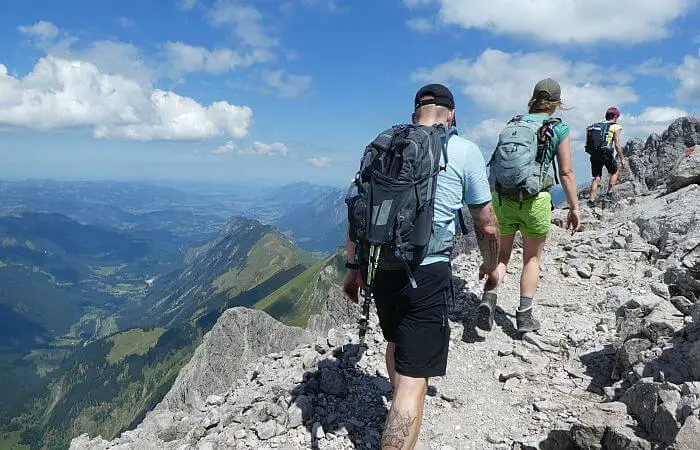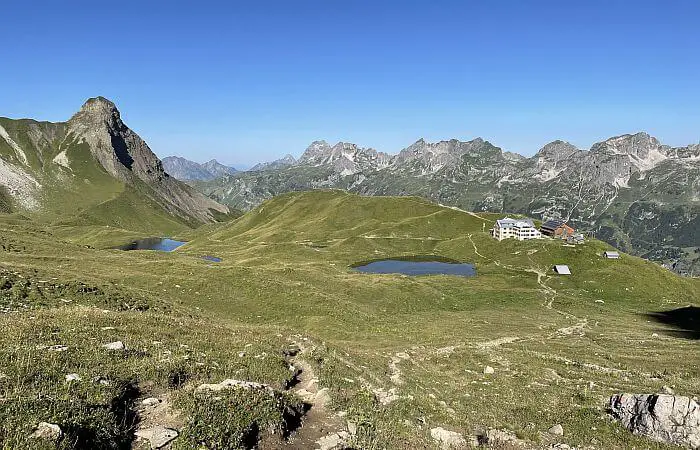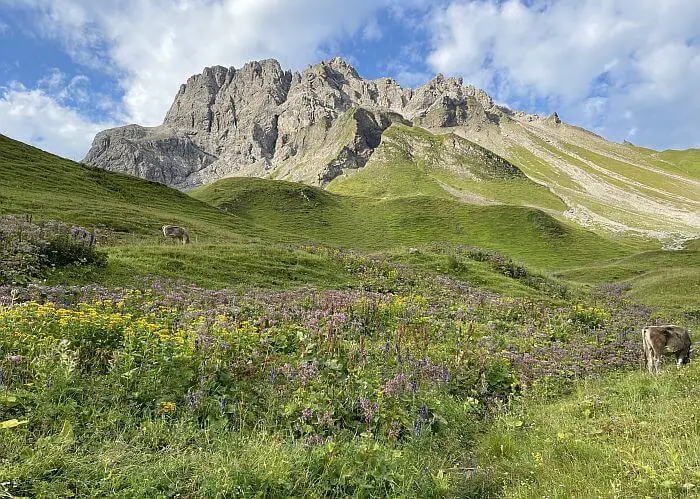Hiking the Heilbronner Weg in the Alps
Story and photos by Tony Robinson-Smith, photos by Nadya Ladouceur
Can a six-mile hike in the Austro-Bavarian Alps really take eight and a half hours? Yes, if you're on the Heilbronner Weg.

No one warned us at Rappensee Hütte. "Oh, you vill hike to Kemptner Hütte tomorrow, vill you?" said the innkeeper. "Vell, be sure to leave early."
But we don't. Our legs are lead after yesterday's six-hour hike from the last inn, and we have just tucked into Gros Früschtuck (Big Breakfast): three rounds of thick Bavarian brown bread with ham, cheese, jam, and coffee. My wife Nadya and I are on a five-day trek in the Alps in the south-eastern corner of Germany, a trek that veers into Austria. We began it two days ago with a ride on the cable car into the mountains from the Austrian village of Riezlern. It will end the day after tomorrow when we descend to the German town of Oberstdorf. Parties of fit-looking Germans depart as we get ready, helmets strapped to their packs, telescopic hiking poles clicking.
The weg (path) begins amicably enough, a gradual incline through grassy meadows freckled with alpine wildflowers. Violet thistles, blue Bellflowers, and purple Bird Vetches rub shoulders with Great Yellow Gentians, Milkwhite Rock Jasmine, and orange-yellow Hawk's Beards. The head of one thistle supports a day-flying Cinnabar moth, its crimson spots gleaming under the morning sun. Tortoiseshell butterflies wander from flower to flower, and Northern Wheatears shoot between boulders making odd crackly squeaks. We keep an eye out for Golden Eagles and Bearded Vultures, known to frequent these parts. After half an hour, we are on a low saddle and pause for a final view of Rappensee Hut, standing alone at 2091 metres above sea level on a grassy terrace overlooking the Rappenalptal valley.

A Well-worn Path Through the Alps
You don't have to carry much on a multi-day hike in the Alps. You can get between huts in a day, and they cater to most needs: bunkbeds in dorms, washrooms (usually no showers), drying rooms, hearty meals, beers on the deck, capuccinos in the lounge, even decks of cards and board games.
Around since 1885, Rappensee Hut has more than 300 beds and is the largest inn belonging to the Alpenverein (Austrian Alpine Club). It sees between 10,000 and 15,000 overnight stays per season (mid-June to early October). Supplies of apfelstrudel, schnitzel, sauerkraut, and Russ (wheat beer) are transported by cable car from the valley. When the Heilbronner Weg opened in 1899, the number of hikers wishing to stay in the hut soared and it has been a popular stop ever since, apart from a few breaks during the wars.
Beyond the saddle, the grass gives out, and the path crosses a field of shattered rock to the foot of a forbidding limestone wall. I am expecting the path to swing to the left or right and wind its merry way up a ravine. But no. Straight up the wall we must climb, zigzagging through rockfall, red paint splashes on boulders signalling the way. I take out our binoculars before we begin. Above the scree, a woman is spread-eagled across the wall, a man reaching for her hand. The pair must be on a climbing expedition although I can't see any harnesses or ropes. Both are wearing helmets.

"Look, Tony, to the left!" Nadya whispers. A stream of tumbling stones, clattering down. The noise shatters the silence.
"Avalanche." Must be plenty of those given how sparse the vegetation is. Lots of loose clinker. The threat in winter of avalanches makes the region too risky for hiking. The cable-car supplying Kemptner Hütte has twice been destroyed.
"No. Further up."
The cause of the avalanche has a dark brown coat, a white belly, and short horns. An Ibex, female. We saw the long, curly, ribbed horns of a male sprouting from the dining room wall of Mindelheimer Hütte on our first night. An ibex's climbing skills are legendary: it can traverse sheer-sided, practically ledge-less mountains with apparent ease. Nudging stones with her nose, this female seems to be in search of a morsel to eat.
Climbing Higher on the Rock Faces
We rise above the scree, following paint splodges. The air is cooler now, the path narrower and steeper. We must watch where we step. Our walking sticks are no longer helpful: we need both hands to grip the rock. After an hour of scrambling and grazing our knees, we arrive at a staircase so steep that we must haul ourselves up hand over hand using steel cable pinned to the wall. It is the first of several such near-vertical ascents. The weg has become a via ferrata.

Then we are in a tunnel just wide enough for a person to squeeze through. We emerge a few minutes later on a windy ledge, bending our knees so as not to fall off. Just as well we are only carrying light packs. A drop of hundreds of feet is an inch from our boots. Neither of us suffers from vertigo, but one false move here and all is lost.
Nadya and I hug the wall and traverse like flies. We cling to cables that take us around gnarly outcrops and up chimneys. Another hour passes. Suddenly, we arrive on a ridge that marks the border between Germany and Austria. A brisk easterly assails us. Fall to the left and we die in Bavaria, to the right in Tyrol. Chests heaving, legs quaking, we squat down to catch our breath.
No sooner have we done so than we have company. Crow-like birds with glossy black feathers and broad wings, yellow beaks and pink legs. They sweep in and park themselves at our elbows, evidently aware that rock-hugging, wingless bipeds are not a threat. Alpine Choughs. One eyes with interest the milch erdnuss riegel (milk peanut bar) I have unwrapped. Another teases a peanut out of a crevice. We are not the first hikers to rest here today.

"May God bless you!" hollers a man of about eighty in the local language, barrelling by when the choughs have gone. His skin is leathery and scorched, his legs and arms thin as sticks. Judging by his effortless gait, he has spent his life hiking the Heilbronner. This phrase or Servus (At your service) are the salutations of Alpen trekkers; no one passes without saying one or the other. Without pausing, the old man heads down the way we have come. He must have left Kemptner Hut at the crack of dawn. We have been walking for three hours, but our map says we are only a third of the way to our destination.
Hiking Trail or Via Ferrata?
Our direction is north, following the ridge and trying not to get blown off. If we were flies on the wall coming up, now, doubled over, we are beetles on a windowsill. The next obstacle is a turret of rock, scalable only with ropes, carabiners, and chalky hands. Fortunately, a steel ladder runs up the side. On the crown, there's another ladder, but this one's horizontal: the route to the next windy turret. Another hour passes. Up, down, up, down, swinging from cables, clambering on all fours. Hiking the Heilbronner ridge is like traversing widely spaced teeth. We ask a woman coming the other way how much more there is. Like the old man, she has an air of breezy unconcern.
"Oh, you're maybe an hour from the snowfield," she replies cryptically. The snowfield? I assume this is a joke. Surely, we are going no higher.
 The weg plunges, the gradient so severe we must ease ourselves down backwards and look between our legs for lips of rock for our feet and hands. Forty minutes of this, and we are at the foot of another daunting wall. Nadya and I rest and watch hikers negotiate the foot-wide switchbacks ascending it. Back home in Canada, a trail like the Heilbronner would be labelled "Black Diamond" or "Only for experienced hikers." There would be fences, railings, and cautions: "Danger! Stay back from the edge" and "Do not go beyond the fence." I ask four young Germans sitting near us whether they have found the path scary. They are pointing at the wall and exchanging looks of mock despair. "We learn when we are children," Stephen replies laughing, "not to be afraid."
The weg plunges, the gradient so severe we must ease ourselves down backwards and look between our legs for lips of rock for our feet and hands. Forty minutes of this, and we are at the foot of another daunting wall. Nadya and I rest and watch hikers negotiate the foot-wide switchbacks ascending it. Back home in Canada, a trail like the Heilbronner would be labelled "Black Diamond" or "Only for experienced hikers." There would be fences, railings, and cautions: "Danger! Stay back from the edge" and "Do not go beyond the fence." I ask four young Germans sitting near us whether they have found the path scary. They are pointing at the wall and exchanging looks of mock despair. "We learn when we are children," Stephen replies laughing, "not to be afraid."
The final ascent only takes twenty minutes, far less time than we expected. A three-meter-high metal cross marks a summit. We are not alone there. A party of fifteen high school kids are breaking into their packed lunches and chatting gaily. Likely ibexes in their previous lives, they show no signs of fatigue or anxiety. The view from Bockkarkopf (2609m) in all directions is of an austere landscape, of jagged, scree-sided cement-gray peaks rising from grassy terraces. The clambering and clinging were worth it.
Much of the way down from the ridge is via ferrata, and our progress is sluggish. It is much easier to haul yourself up on a steel cable than it is to let yourself down on one. Finally, the gradient eases, and we are able to walk without using our hands.
Alpine Waters and a Reward

It is mid-afternoon when we enter the snowfield. Despite it being late summer, a hollow a hundred meters wide contains wet snow. We trudge across, our boots breaking the crust in places and finding the meltwater below. Our descent continues to a lake in a shallow cirque, where we join Stephen and his three pals, Sebastian, Alex, and Michael. It is good to see them: fellow survivors of the Heilbronner. We should take a dip here, they say, as Kemptner Hut has no showers.
The water is frigid, but it is a relief to bathe. Drying off under the sun, we hear the music of the Alps, a sound we have heard from day one of our hike. Chestnut brown cows with white muzzles are grazing the slopes, the bells on their necks clonking every time they tear the grass. There are shrill squeals, too, that we assume come from birds until we spot squirrel-like heads poking out of burrows. Alpine Marmots.
I ask Martin, the innkeeper, when we arrive exhausted at Kemptner Hut and have downed our first pint of Russ, whether there are any fatalities on the Heilbronner Weg.

"Nay," he replies. "But some people break hand or leg. Sometimes, the helicopter must come. But it is alright. It is worth the beer!"
Tony Robinson-Smith is the author of Back in 6 Years: A Journey around the Planet without leaving the Surface and The Dragon Run: Two Canadians, Ten Bhutanese, One Stray Dog, which tells of his 578 km run across the Bhutanese Himalaya to raise money to send village kids to school. He and his wife spent three months traveling in the Papua New Guinean interior, paddling dug-out canoes down the Sepik, scrambling up Mt. Wilhelm, and tracking down elusive Birds of Paradise. Check out his blog for more.
Related Features:
Accepting Fate on the GR7 Hiking Trail of Spain - Jeremy Bassetti
Hiking Sweden Alone and Lost in Abisko National Park - Madelaine Triebe
Crossing the Creases of Wild Kyrgyzstan - Tim Leffel
How to Lose Friends and Mortify People While Hiking in Peru - Marco Ferrarese
See other Europe travel stories from the archives
Copyright © Perceptive Travel 2022. All rights reserved.
- In Bed With the Seal Team in Iceland by Rachel Dickinson
- Searching for Nauru Tourism on a Troubled Tiny Island by Brandi Mueller
- Puerto Rican Music, Mofongo, and Murals — Finding the Soul of a Limbo State by Tim Leffel
- Travel Book Reviews by William Caverlee
Books from the Author:

Buy The Dragon Run at your local bookstore, or get it online here:
Amazon
Amazon UK
Amazon Canada

Buy Back in 6 Years: A Journey Around the World at your local bookstore, or get it online here:
Amazon
Amazon UK
Amazon Canada

